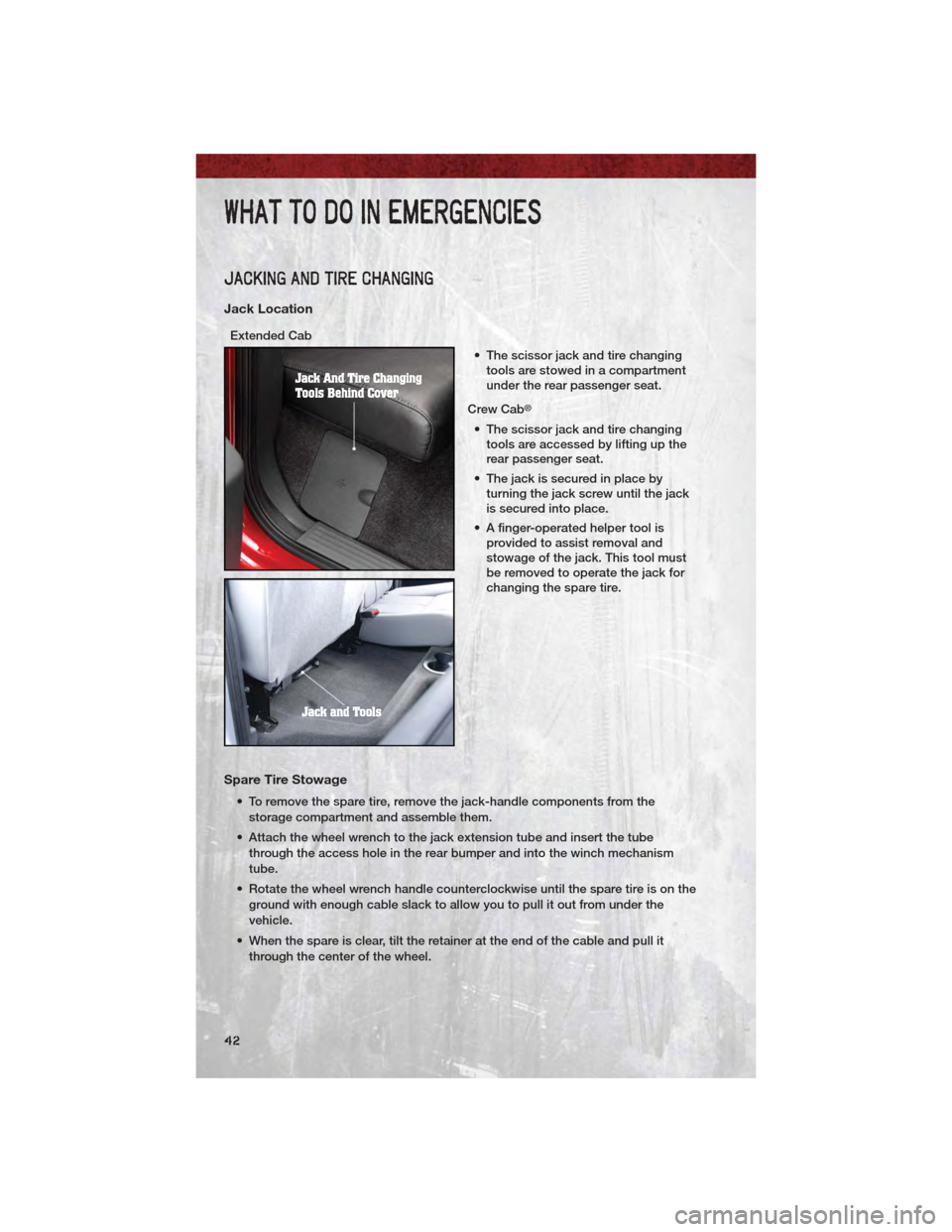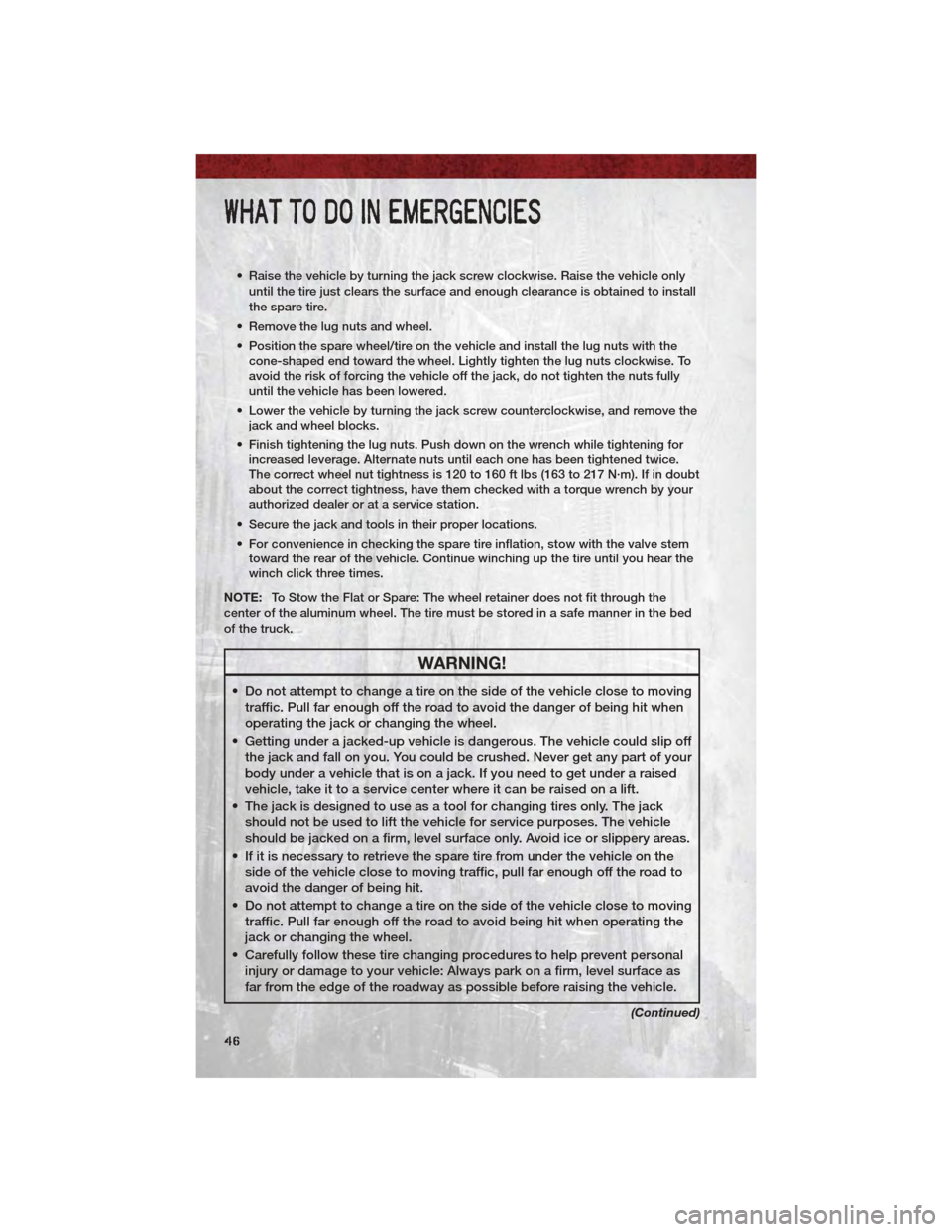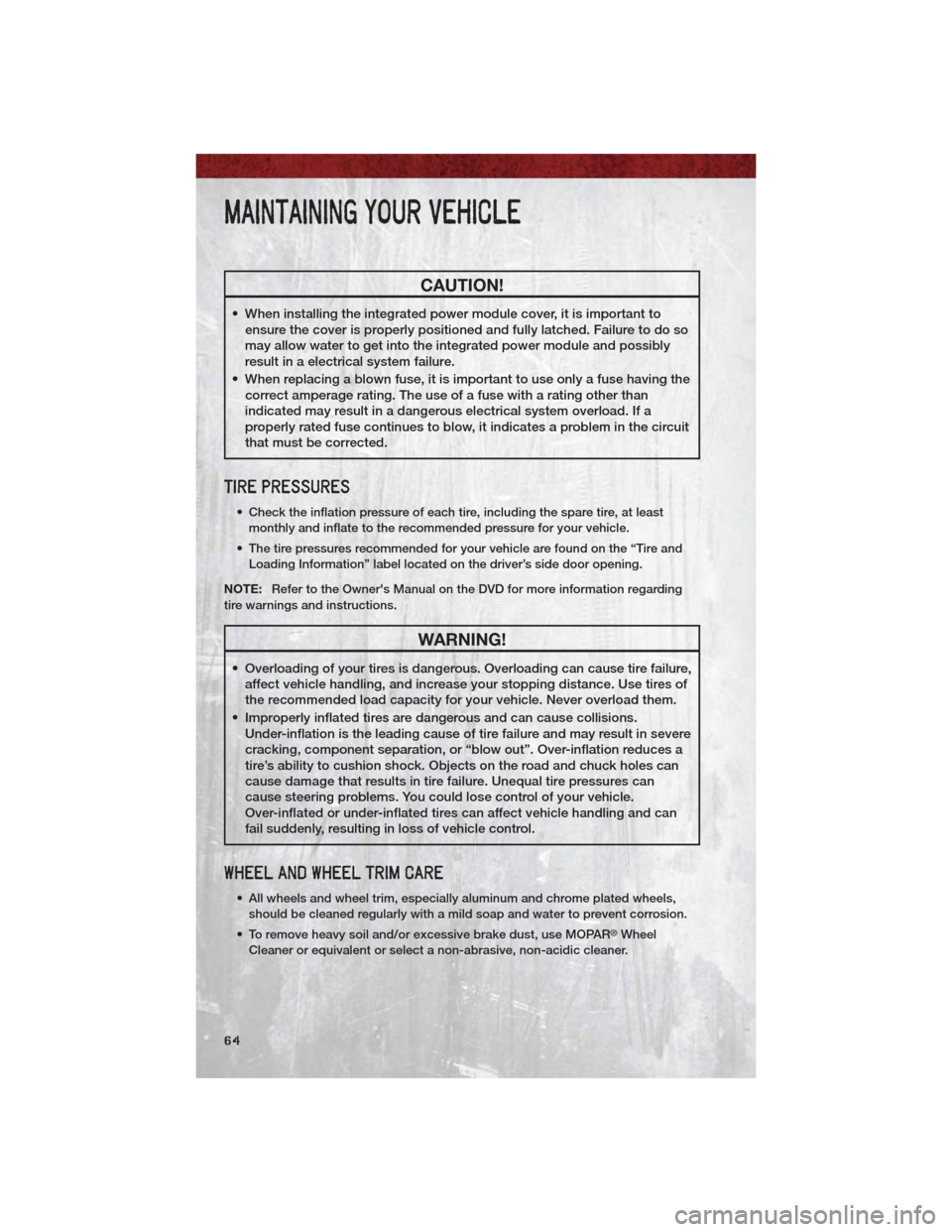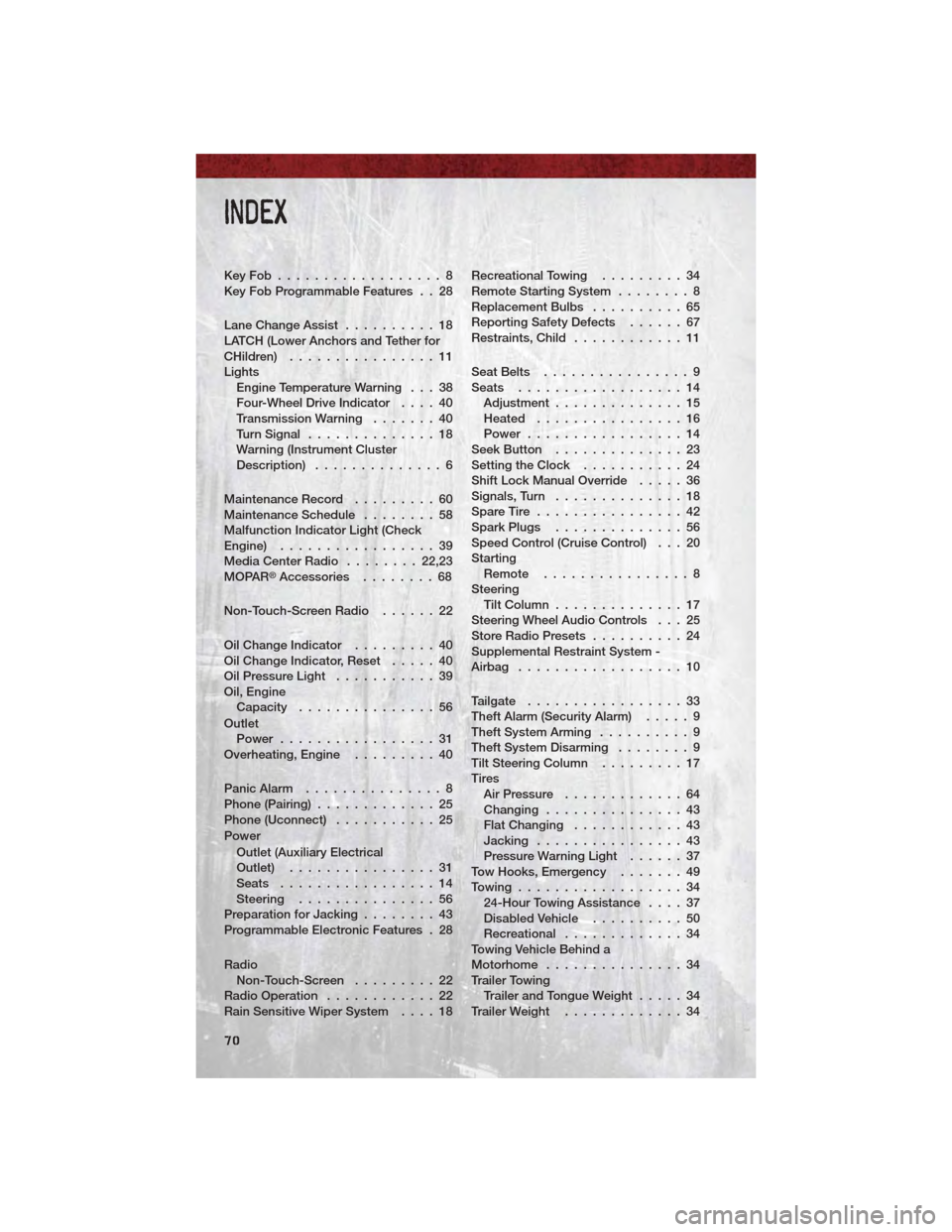spare wheel DODGE DAKOTA 2011 3.G User Guide
[x] Cancel search | Manufacturer: DODGE, Model Year: 2011, Model line: DAKOTA, Model: DODGE DAKOTA 2011 3.GPages: 76, PDF Size: 4.62 MB
Page 44 of 76

JACKING AND TIRE CHANGING
Jack Location
Extended Cab• The scissor jack and tire changingtools are stowed in a compartment
under the rear passenger seat.
Crew Cab
®
• The scissor jack and tire changing tools are accessed by lifting up the
rear passenger seat.
• The jack is secured in place by turning the jack screw until the jack
is secured into place.
• A finger-operated helper tool is provided to assist removal and
stowage of the jack. This tool must
be removed to operate the jack for
changing the spare tire.
Spare Tire Stowage
• To remove the spare tire, remove the jack-handle components from the
storage compartment and assemble them.
• Attach the wheel wrench to the jack extension tube and insert the tube through the access hole in the rear bumper and into the winch mechanism
tube.
• Rotate the wheel wrench handle counterclockwise until the spare tire is on the ground with enough cable slack to allow you to pull it out from under the
vehicle.
• When the spare is clear, tilt the retainer at the end of the cable and pull it through the center of the wheel.
WHAT TO DO IN EMERGENCIES
42
Page 45 of 76

Preparations For Jacking
• Park on a firm, level surface. Avoid ice or slippery areas.
• Set the parking brake and shift the automatic transmission into PARK. OnFour-Wheel Drive vehicles, shift the transfer case to the 4L position.
• Turn the ignition to LOCK and turn on the Hazard Warning flasher. • Block both the front and rear of thewheel diagonally opposite of the
jacking position. For example, if
changing the right front tire, block
the left rear wheel.
NOTE: Passengers should not remain in
the vehicle when the vehicle is being
jacked.
Jacking And Tire Changing Instructions
• Remove the spare tire, jack and tools from their stored location.
• Loosen (but do not remove) the wheel lug nuts by turning them counterclockwise one turn while the wheel is still on the ground.
• Assemble the jack and jacking tools. Connect the jack handle driver to the extension, then to the lug wrench.
WHAT TO DO IN EMERGENCIES
43
Page 48 of 76

• Raise the vehicle by turning the jack screw clockwise. Raise the vehicle onlyuntil the tire just clears the surface and enough clearance is obtained to install
the spare tire.
• Remove the lug nuts and wheel.
• Position the spare wheel/tire on the vehicle and install the lug nuts with the cone-shaped end toward the wheel. Lightly tighten the lug nuts clockwise. To
avoid the risk of forcing the vehicle off the jack, do not tighten the nuts fully
until the vehicle has been lowered.
• Lower the vehicle by turning the jack screw counterclockwise, and remove the jack and wheel blocks.
• Finish tightening the lug nuts. Push down on the wrench while tightening for increased leverage. Alternate nuts until each one has been tightened twice.
The correct wheel nut tightness is 120 to 160 ft lbs (163 to 217 N·m). If in doubt
about the correct tightness, have them checked with a torque wrench by your
authorized dealer or at a service station.
• Secure the jack and tools in their proper locations.
• For convenience in checking the spare tire inflation, stow with the valve stem toward the rear of the vehicle. Continue winching up the tire until you hear the
winch click three times.
NOTE: To Stow the Flat or Spare: The wheel retainer does not fit through the
center of the aluminum wheel. The tire must be stored in a safe manner in the bed
of the truck.
WARNING!
• Do not attempt to change a tire on the side of the vehicle close to moving traffic. Pull far enough off the road to avoid the danger of being hit when
operating the jack or changing the wheel.
• Getting under a jacked-up vehicle is dangerous. The vehicle could slip off the jack and fall on you. You could be crushed. Never get any part of your
body under a vehicle that is on a jack. If you need to get under a raised
vehicle, take it to a service center where it can be raised on a lift.
• The jack is designed to use as a tool for changing tires only. The jack should not be used to lift the vehicle for service purposes. The vehicle
should be jacked on a firm, level surface only. Avoid ice or slippery areas.
• If it is necessary to retrieve the spare tire from under the vehicle on the side of the vehicle close to moving traffic, pull far enough off the road to
avoid the danger of being hit.
• Do not attempt to change a tire on the side of the vehicle close to moving traffic. Pull far enough off the road to avoid being hit when operating the
jack or changing the wheel.
• Carefully follow these tire changing procedures to help prevent personal injury or damage to your vehicle: Always park on a firm, level surface as
far from the edge of the roadway as possible before raising the vehicle.
(Continued)
WHAT TO DO IN EMERGENCIES
46
Page 66 of 76

CAUTION!
• When installing the integrated power module cover, it is important toensure the cover is properly positioned and fully latched. Failure to do so
may allow water to get into the integrated power module and possibly
result in a electrical system failure.
• When replacing a blown fuse, it is important to use only a fuse having the correct amperage rating. The use of a fuse with a rating other than
indicated may result in a dangerous electrical system overload. If a
properly rated fuse continues to blow, it indicates a problem in the circuit
that must be corrected.
TIRE PRESSURES
• Check the inflation pressure of each tire, including the spare tire, at least
monthly and inflate to the recommended pressure for your vehicle.
• The tire pressures recommended for your vehicle are found on the “Tire and Loading Information” label located on the driver’s side door opening.
NOTE: Refer to the Owner's Manual on the DVD for more information regarding
tire warnings and instructions.
WARNING!
• Overloading of your tires is dangerous. Overloading can cause tire failure, affect vehicle handling, and increase your stopping distance. Use tires of
the recommended load capacity for your vehicle. Never overload them.
• Improperly inflated tires are dangerous and can cause collisions. Under-inflation is the leading cause of tire failure and may result in severe
cracking, component separation, or “blow out”. Over-inflation reduces a
tire’s ability to cushion shock. Objects on the road and chuck holes can
cause damage that results in tire failure. Unequal tire pressures can
cause steering problems. You could lose control of your vehicle.
Over-inflated or under-inflated tires can affect vehicle handling and can
fail suddenly, resulting in loss of vehicle control.
WHEEL AND WHEEL TRIM CARE
• All wheels and wheel trim, especially aluminum and chrome plated wheels,
should be cleaned regularly with a mild soap and water to prevent corrosion.
• To remove heavy soil and/or excessive brake dust, use MOPAR
®Wheel
Cleaner or equivalent or select a non-abrasive, non-acidic cleaner.
MAINTAINING YOUR VEHICLE
64
Page 72 of 76

KeyFob..................8
Key Fob Programmable Features . . 28
Lane Change Assist..........18
LATCH (Lower Anchors and Tether for
CHildren) ................11
Lights Engine Temperature Warning . . . 38
Four-Wheel Drive Indicator ....40
Transmission Warning .......40
Turn Signal ..............18
Warning (Instrument Cluster
Description) ..............6
Maintenance Record .........60
Maintenance Schedule ........58
Malfunction Indicator Light (Check
Engine) .................39
Media Center Radio ........22,23
MOPAR
®Accessories ........68
Non-Touch-Screen Radio ......22
Oil Change Indicator .........40
Oil Change Indicator, Reset .....40
Oil Pressure Light ...........39
Oil, Engine Capacity ...............56
Outlet Power .................31
Overheating, Engine .........40
Panic Alarm ...............8
Phone (Pairing) .............25
Phone (Uconnect) ...........25
Power Outlet (Auxiliary Electrical
Outlet) ................31
Seats .................14
Steering ...............56
Preparation for Jacking ........43
Programmable Electronic Features . 28
Radio Non-Touch-Screen .........22
Radio Operation ............22
Rain Sensitive Wiper System ....18Recreational Towing
.........34
Remote Starting System ........8
Replacement Bulbs ..........65
Reporting Safety Defects ......67
Restraints,Child ............11
SeatBelts ................9
Seats ..................14 Adjustment ..............15
Heated ................16
Power .................14
SeekButton ..............23
Setting the Clock ...........24
Shift Lock Manual Override .....36
Signals, Turn ..............18
SpareTire ................42
SparkPlugs ..............56
Speed Control (Cruise Control) . . . 20
Starting Remote ................8
Steering TiltColumn..............17
Steering Wheel Audio Controls . . . 25
Store Radio Presets ..........24
Supplemental Restraint System -
Airbag ..................10
Tailgate .................33
Theft Alarm (Security Alarm) .....9
Theft System Arming ..........9
Theft System Disarming ........9
TiltSteeringColumn .........17
Tires Air Pressure .............64
Changing ...............43
Flat Changing ............43
Jacking ................43
Pressure Warning Light ......37
Tow Hooks, Emergency .......49
Towing..................34 24-Hour Towing Assistance ....37
DisabledVehicle ..........50
Recreational .............34
Towing Vehicle Behind a
Motorhome ...............34
Trailer Towing Trailer and Tongue Weight .....34
TrailerWeight .............34
INDEX
70